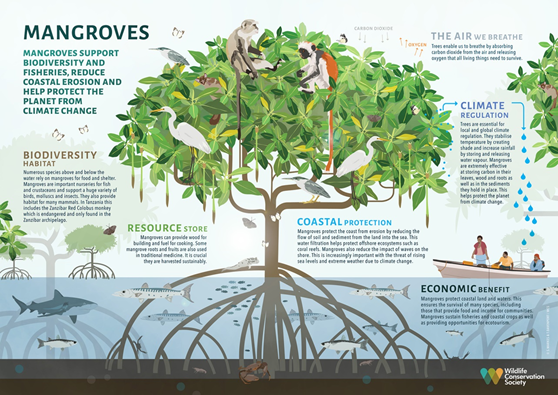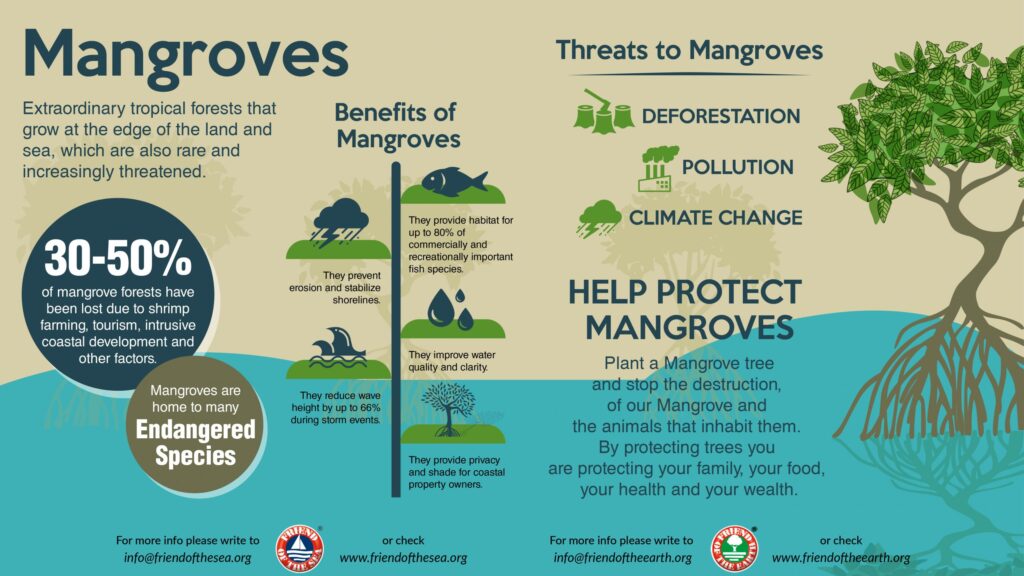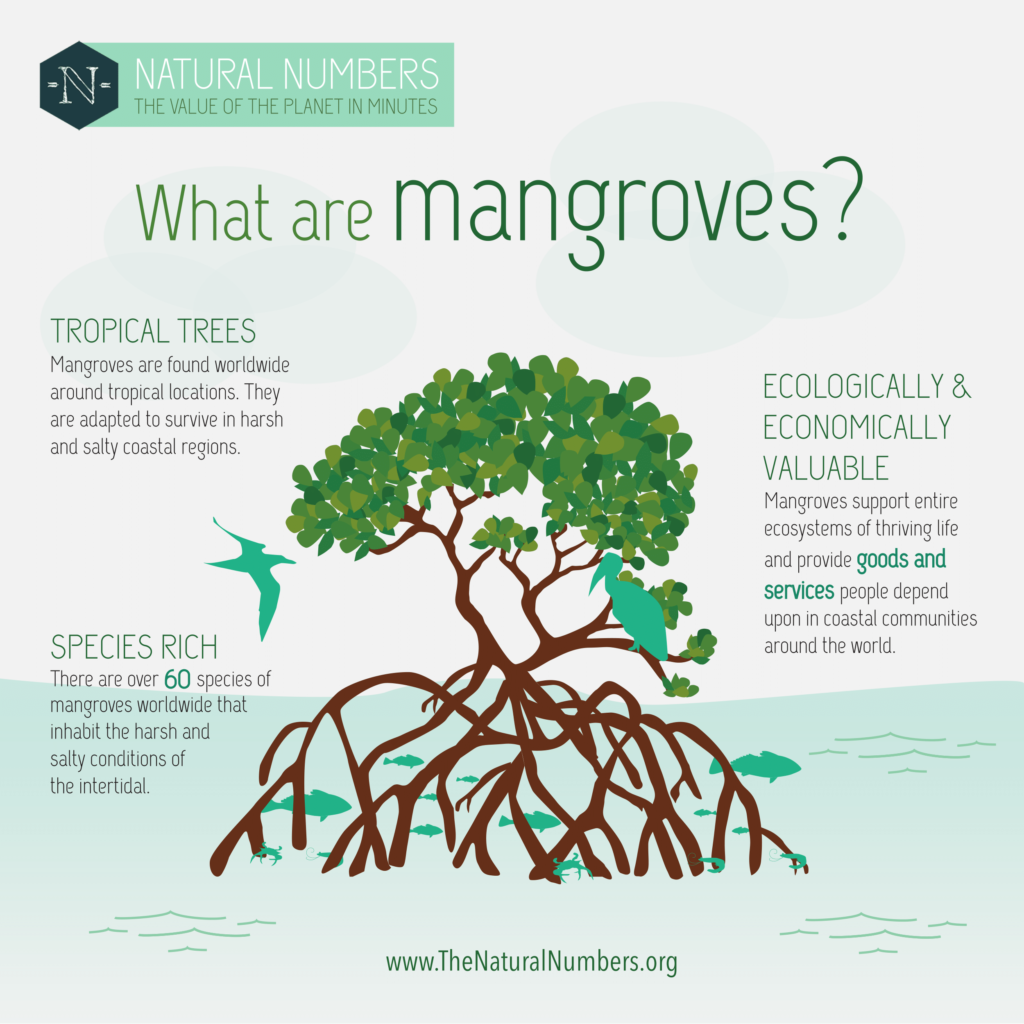



Every year on July 26, the International Day for the Conservation of the Mangrove
Ecosystem is celebrated. The day was designated by UNESCO in 2015 to raise
awareness on the integral role of mangrove ecosystems as unique, special and
vulnerable ecosystems, and to promote solutions for their conservation, sustainable
management and utility. (IUCN.ORG)
Mangroves are a unique group of trees and shrubs that have adapted to live in coastal
intertidal zones, characterized by their ability to thrive in saltwater environments and
low-oxygen soil conditions. Belonging to various species and families, mangroves play a
critical role in coastal ecosystems for their biodiversity and ability to protect the
coastlines from erosion. Mangroves provide valuable ecosystem services for human
well-being including provisioning, regulation, habitat and cultural services. Mangroves
provide timber, firewood, charcoal and blue carbon storage; regulate flooding, buffer
storms, protect coastlines with erosion control, and mitigate salt water intrusion; provide
nursery habitats, breeding and spawning grounds for commercial fish species,
crustaceans and other biodiversity; and cultural services such as recreation and for
aesthetic appreciation for greenery. (IUCN.ORG)
Mangroves in the Philippines. In 2013, global Landsat imaging done from 1990-2010
by Jordan B. Long of EROS and Chandra Giri of ARSC, both of which were
contractors of USGS in South Dakota, published in the Journal of Coastal Research, the
estimated total area of Philippine mangrove coverage at 256, 185 hectares in 2000,
which was a bit higher than DENR’s estimate of 247,362 hectares in 2003.
The report finds 66 out of 82 (80%) provinces have mangroves; and identified the top
provinces with the most mangrove areas as a percentage of total national area:
Palawan (22.2%), Sulu (8%), and Zamboanga del Norte and Sur (9.86%); Surigao del
Norte and Sur (6.8%), Eastern and Western Samar (6.1%), Quezon (5.5%), Tawi-Tawi
(4.4%), Bohol (3.69%), and Basilan (2.97%). About 49K hectares (19%) of total national
area is protected by IUCN for long-term conservation purposes. These protected
mangroves are in Palawan, Siargao, Malampaya Sound, Biri Larosa, El Nido, Tanon
Strait, Northern Sierra Madre, Dumanquilas Bay, Sibuyan Islands, and Calauit Island.
Importance of Mangrove ecosystem services:
Fisheries: The mangrove forest is home to a large variety of fish, crab, shrimp,
and mollusk species. These fisheries form an essential source of food for
thousands of coastal communities. The forests serve as nurseries for coral reef
fish and other fish.
Timber and plant products: The mangrove wood is resistant to rot and insects,
making it extremely valuable. Many coastal and indigenous communities rely on
this wood for construction material, firewood, wood chips, pulp, and charcoal.
These communities also collect medicinal plants from mangrove ecosystems
and use mangrove leaves as animal fodder.
Coastal protection: The dense root systems of mangrove forests root systems
trap sediments flowing from rivers and off the land. Trapped sediments help
stabilize the coastline and prevent erosion from hurricanes, high waves, storms
and floods. And by filtering out the sediments, the mangroves protect coral reefs
and seagrass meadows from being smothered in sediment. In areas where
mangroves had been cleared, coastal damage caused by natural disaster is
much more severe.
Tourism: Given the diversity of life inhabiting mangrove systems, and likely
proximity to other tourist spots such as coral reefs and sandy beaches, it is
surprising that only a few countries have tapped into the tourism potential of
their mangrove forests. Bicol and Palawan offer snorkeling expeditions in and
around mangroves to witness a variety of fish against an enchanting scenario of
interwoven roots delving deep into the sand. Potential revenue generation lies in
tourism with on-site learning about mangrove forests.
Threats. The mangrove forests are one of the world’s most threatened tropical
ecosystems. More than 35% of the world’s mangroves are already gone. The rate of
disappearing mangroves in this century is up to 50% in countries such as India,
Philippines, and Vietnam, while in the Americas they are being cleared at a rate faster
than tropical rainforests. Although natural disasters are big threats, man-made pollution
is the biggest threat to mangroves. The threats include:
Clearing: The mangrove forests are being cleared to make room for agriculture,
human settlements, and infrastructure such as piers, airports, industrial zones,
tourist developments, aquaculture, and salt farms resulting in major mangrove
loss.
Overharvesting: Over-harvesting mangrove trees have taken place for
centuries and it is no longer sustainable, threatening the future of
the mangrove forests.
River changes: Dams and irrigation reduce the amount of water reaching
mangrove forests, changing the salinity level of water in the forest. If salinity is
too high, the mangroves cannot survive. Diverted freshwater can lead
to mangroves drying out. Increased erosion due to land deforestation can
massively increase the amount of sediment in rivers. This affects the mangrove’s
filtering ability, leading to a dying mangrove forest.
Overfishing: The global overfishing crisis facing the world’s oceans also affects
the ecological balance of the food chains and mangrove fish communities.
Destruction of coral reefs: Coral reefs are home to 25% of marine life and
simultaneously provide the first barrier against currents and strong waves. When
destroyed, the stronger-than-normal waves and currents reaching the coast can
undermine the fine sediment where mangroves grow. This prevents seedlings
from taking root and washes away nutrients essential for mangrove ecosystems
to flourish.
Pollution: Fertilizers, pesticides, sewage, and other toxic man-made chemicals
carried by river systems from upstream sources can kill animals living in
mangrove forests, while oil pollution can choke mangrove roots and suffocate
the trees.
Climate change: The mangrove forests require stable sea levels for long-term
survival. Coastal habitats are already getting flooded and corals bleached. Rapid
sea level rise will likely be the greatest climate change challenge
to mangrove ecosystems. (maritimereview.ph)
This year highlights the theme “Mangroves: Stewards of Blue Economy” it
emphasizes the crucial role of mangrove ecosystem stewardship in sustaining
biodiversity, providing ecosystem services and stabilizing the blue economy. The blue
economy encompasses many activities such as: renewable energy, tourism, climate
change, fisheries, waste management and maritime transport. (worldbank.org/oceans)
Together let’s conserve and protect the mangrove ecosystem most valuable and unique
habitats on our planet. Happy International Day for the Conservation of the Mangrove
Ecosystems!
